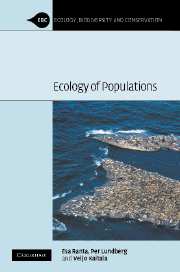Book contents
- Frontmatter
- Contents
- Preface
- 1 Introduction
- 2 Population renewal
- 3 Population dynamics in space – the first step
- 4 Synchronicity
- 5 Order–disorder in space and time
- 6 Structured populations
- 7 Biodiversity and community structure
- 8 Habitat loss
- 9 Population harvesting and management
- 10 Resource matching
- 11 Spatial games
- 12 Evolutionary population dynamics
- 13 Epilogue
- References
- Index
9 - Population harvesting and management
Published online by Cambridge University Press: 02 December 2009
- Frontmatter
- Contents
- Preface
- 1 Introduction
- 2 Population renewal
- 3 Population dynamics in space – the first step
- 4 Synchronicity
- 5 Order–disorder in space and time
- 6 Structured populations
- 7 Biodiversity and community structure
- 8 Habitat loss
- 9 Population harvesting and management
- 10 Resource matching
- 11 Spatial games
- 12 Evolutionary population dynamics
- 13 Epilogue
- References
- Index
Summary
Apart from giving us a general and fundamental understanding of dynamic processes at the population and community level, population ecology also has obvious practical connections and associations. It helps us to analyze and manage natural populations. In this chapter, we address selected aspects of population management. We first consider problems related to conservation issues, i.e., dealing with small and/or declining populations. The other side of the coin is pest management, not dealt with here however. We then focus on exploited populations, where there is generally a trade-off between the number of individuals (or amount of biomass) removed and the viability of the target population, i.e., the problem of sustainability. We do this by emphasizing the need for rigorous risk analysis procedures.
From a conservation point of view, we become concerned when the number of individuals of a species declines to low numbers, or when a particular population of a species becomes small. There is, of course, an ongoing debate about what the appropriate conservation units really are – should we, e.g., only focus on species preservation when there is so much biological diversity (genetic and phenotypic) also within a species? We take no stand in this debate here, and we boldly neglect the concern about genetic diversity. Here, it will be assumed that the population is a useful and reasonably well-defined entity, and that the population is an appropriate management unit.
- Type
- Chapter
- Information
- Ecology of Populations , pp. 213 - 236Publisher: Cambridge University PressPrint publication year: 2005



